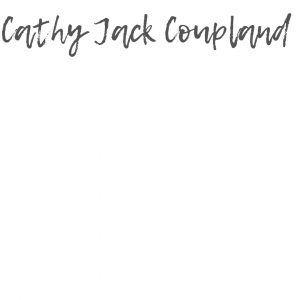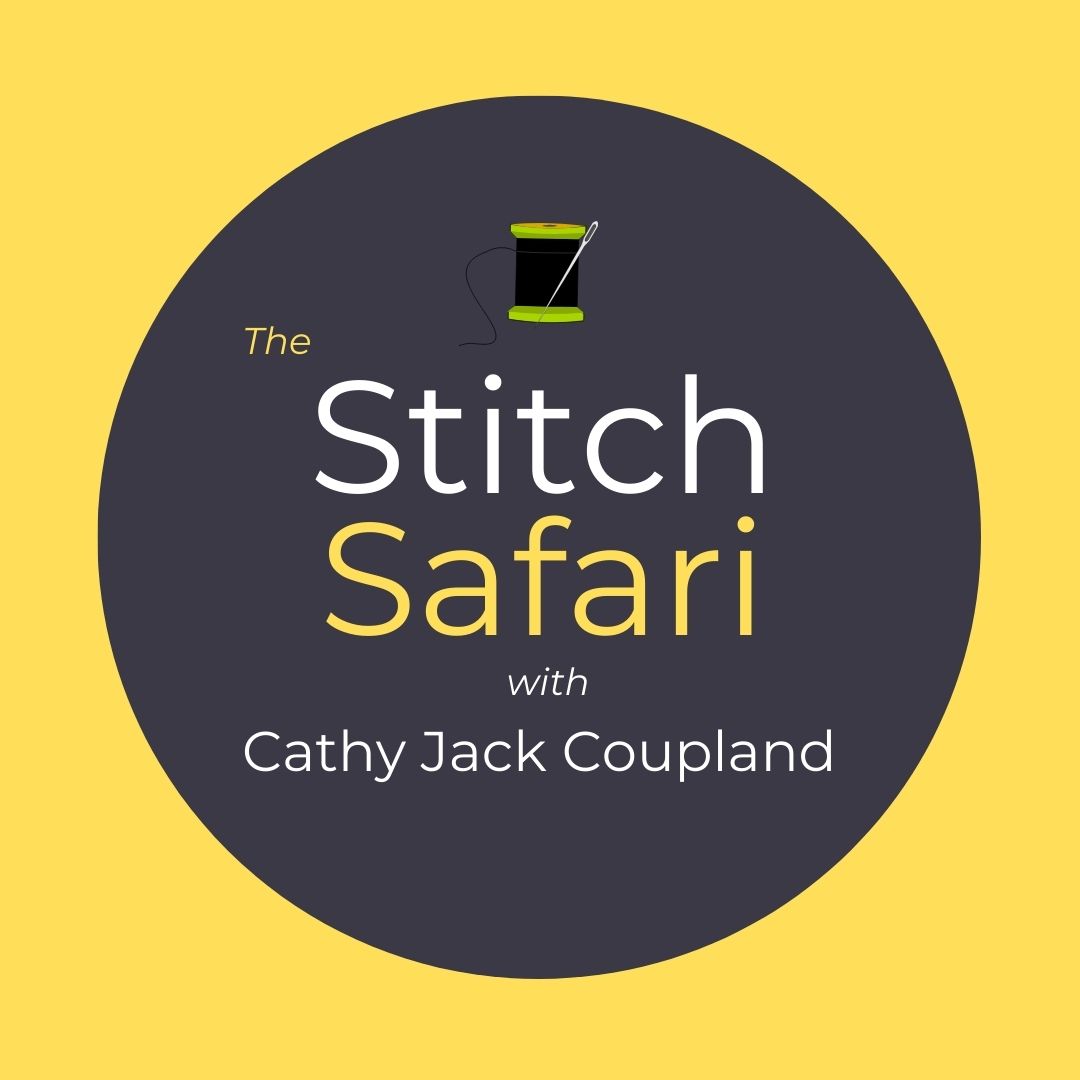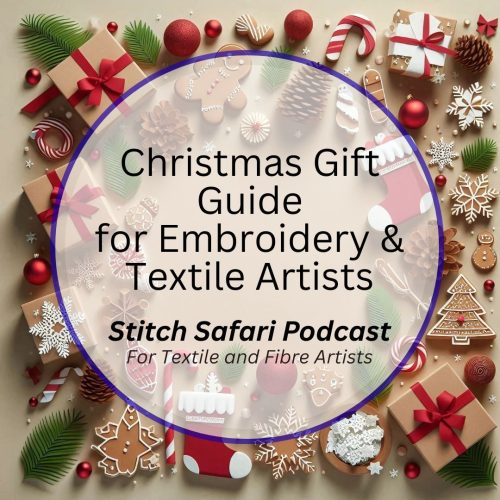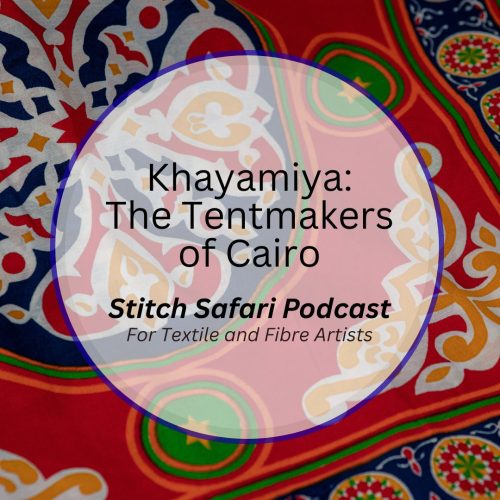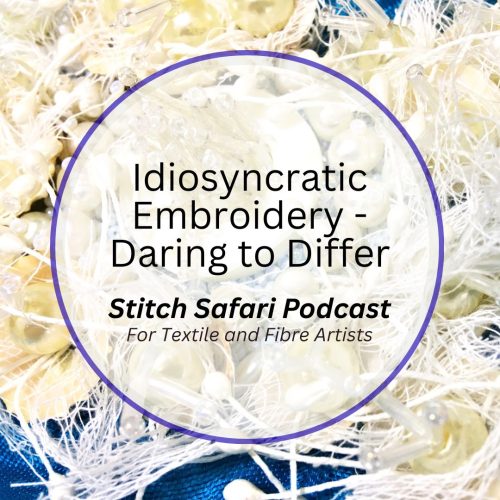This is a follow-up to the last episode of the Stitch Safari Podcast, Masters of Our Machines, and focuses on books offering inspiration, technique, and thoughts on the artistry of machine embroidery today.
In the vast sea that makes up the book world which are the types of books, you know the ones, that can make a difference, change a direction, inspire process or increase our knowledge and understanding of a sewing machine’s capabilities?
Well, look no longer. I have some suggestions for you right here.
So Stitch Safari Listeners, without any further ado, let me introduce the following books to you – books that I find technically instructive and inspiring.
These books are offered in no particular order – but I acknowledge by including them here, they are in my opinion, worth looking out in a library, second-hand bookstore, or buying online.
Book No. 1: Freestyle Machine Embroidery – Techniques and Inspiration for Fiber Art written by Carol Shinn, published by Interweave Press in 2009.
Now I rate this book highly because Carol takes the time to share her knowledge about the process of freestyle machine embroidery, colour mixing, her process for embroidery, adding variety and finishing with a gallery of images featuring some wonderful examples of freestyle machine embroidery used as an artistic medium.
But wait, there’s more. The book also covers the workspace and equipment, basic colour information, ways to re-proportion artwork for embroidery, distortion, recommended books and American suppliers.
There’s info and images on zig-zag and satin stitch effects, how to create moss stitch, working upside down with a loose top tension forming delicious loops of thread on the underside, creating granite stitch, troubleshooting and how to plan and stitch a complete design.
But one of the best inclusions in this book is Chapter 2, where Carol hones in on Colour Mixing – this is an outstanding description of layering colours to be able to understand and create a seamless colour gradation from one colour to another – and the reason I know this is that I’ve worked through this example from this book.
The book begins with an overview of the process of freestyle machine embroidery which is described clearly and supported by drawings and images.
This is a sound technical, how-to style book offering a vast array of information on how to work with your feed dogs down – or freestyle as Carol calls it.
Book No. 2: Organic Embroidery written by Meredith Woolnough, Published by Schiffer Publishing Ltd, in 2018.
Meredith Woolnough’s talent and ability with a machine shines from every page of this well-presented and visually appealing book.
It has a very clean, modern look. In her introduction, Meredith notes ‘her aim for this book is to provide an instructional and inspirational resource tool suitable for all levels of creators and makers. She hopes that her practice will motivate you to get outdoors more, to experience nature and to use its wonders to inspire your own original artworks’.
Now the technique used throughout is still feed-dogs down or freestyle machine embroidery, however, Meredith works with dissolvable fabrics to create dimensional, lacy textured artworks of exquisite beauty and delicacy.
What’s interesting here is that Meredith encourages the reader to research and develop by including botanical fieldwork, drawing and annotation including underwater research. Drawing, photography and studying these natural specimens produce a visual resource to inspire and inform work.
Meredith writes about keeping a sketchbook and developing artwork designs for embroidery with numerous images to support the text.
Then comes the process of ‘drawing with a sewing machine’ covering tools and materials, getting started, single line stitching, dense stitching, painting with stitch, working with zig-zag, working with layers and colour blending.
Meredith covers the dissolving and sculpting process and designing for three dimensions.
The book finishes with tips and troubleshooting that should be read and re-read because this information is invaluable.
Book No. 3: Lindsay Taylor Embroidered Art, published by Search Press in 2013.
This is a book of whimsy, dreams and forest-filled imagination and it’s a rare treat to see such originality and talent presented so beautifully.
It’s a world of bags, teacups and cabbages, of will-of-the-wisp shoes and fly-away butterflies – it’s a fantasy world bursting with originality and imagination.
The book touches on Lidsay’s life, the materials and threads she works with and the techniques she uses.
This is 3D free-machine embroidery which aligns perfectly with Lindsay’s pattern cutting, moulding and sculpting background and includes working with water-soluble fabrics stitched in a hoop, stitching into cloth or using a fabric sandwich. Construction, and finishing touches such as burning, and working with wire, felt, cords, tassels and beads are also discussed.
If you love the idea of observing nature, and then replicating your ideas through stitch, this book is for you.
For me, it’s the shoes – I adore them. Mossy, dripping with snowdrops, displayed in glass Cinderalla-like boxes, or sprouting delicate primroses or bronzed leaves, the shoes and the rest of the featured works represent the utter charm and wispiness of yet another form of free machine embroidery.
Book No. 4: Celtic Inspirations for Machine Embroiderers written by Valerie Campbell-Harding and Maggie Grey, published by BT Batsford in 2002
Twenty-two years old, and still giving, this book is worth looking out for. Valerie Campbell-Harding and Maggie Grey are well-known English embroiderers who have authored several embroidery books separately before collaborating to produce this wonderful publication.
This is very much a design and technique-based book, which is only a plus in my opinion, however, machine embroidery techniques are used throughout.
Machine embroidery is extended in ways not often seen, and renewing and polishing some of these ideas could produce some exciting and innovative new work.
As you can imagine with Celtic design work, lettering and scrollwork feature throughout but what’s of interest is how machine embroidery is incorporated into the work with the use of water-soluble fabric, layering, threading, distortion, different sewing attachments, wire, cut-outs used as applique, worked on a variety of materials and worked with metal and meshes.
There’s a great deal of inspiration here, making it a good basis for a sampler of design ideas and machine techniques for someone starting their machine-stitched journey.
Book No. 5: Three-Dimensional Embroidery by Janet Edmonds, published in 2005 by Batsford
Another book that’s been around for a while yet still gives wonderful and exciting inspiration and scope for new work.
While not primarily directed towards machine stitch, this book shows the processes that can take your work off the drawing board into the world of 3 dimensions to include structures and decorative surfaces that are integral to the form – and some of this work is performed using machine techniques.
Also discussed are ways to create edges, bases, feet and lids to finish work – things that are not always discussed or written about.
It’s the sort of book that will make you think of possibilities, so is probably geared more towards those with some stitching confidence.
As a construction tool, the machine is your friend.
Lastly, Book 6: Machine Stitch Perspectives by Alice Kettle and Jane McKeating, published by A & C Black Publishers Limited, London in 2010.
Described as an essential read and reference for any textile student, practising embroiderer, designer or artist this book draws on the knowledge and expertise of a team of well-known and influential embroiderers who explore the creative potential of machine-made stitch and how machines can be utilised within contemporary artistic contexts.
Drawing upon resources such as The Fashion Museum, Platt Hall Museum of Costume and Manchester Metropolitan University with its unique and diverse archive of machines, samples and artworks, this book aims to reveal the fascinating history of sewing machine development and computerisation, while demonstrating its worth as a creative tool.
With chapters written by experts in their field covering topics such as ‘The Pleasures of the Machine-Stitched Mark’ by Judy Barry or Nigel Hurlstone’s ‘Drawing and the Chimera of Embroidery’ along with fabulous images and numerous examples of work, this book brings together knowledge and possibility.
In a world of endless classes, workshops and tutorials, there’s nothing better than to work and learn from home from a book written by a master in their field – and each of these authors is a master.
I have to wonder what those early designers of sewing machines would think of modern machines now.
